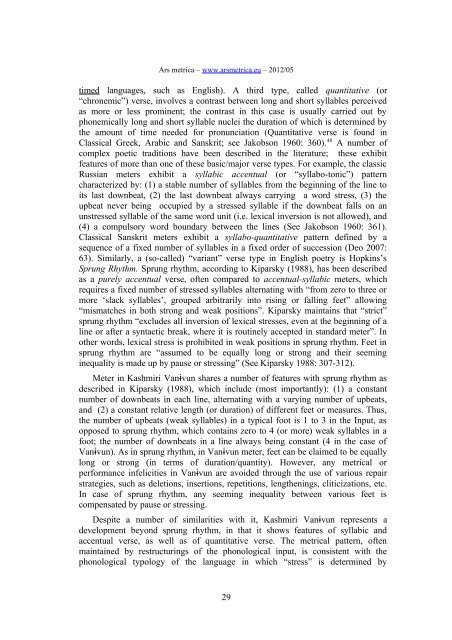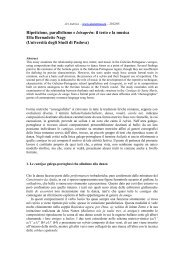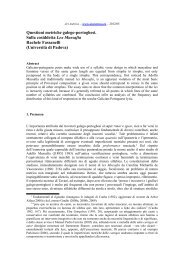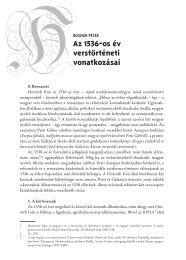The Metrical Structure of Kashmiri Vanɨvun Sadaf ... - Ars Metrica
The Metrical Structure of Kashmiri Vanɨvun Sadaf ... - Ars Metrica
The Metrical Structure of Kashmiri Vanɨvun Sadaf ... - Ars Metrica
Create successful ePaper yourself
Turn your PDF publications into a flip-book with our unique Google optimized e-Paper software.
<strong>Ars</strong> metrica – www.arsmetrica.eu – 2012/05<br />
timed languages, such as English). A third type, called quantitative (or<br />
“chronemic”) verse, involves a contrast between long and short syllables perceived<br />
as more or less prominent; the contrast in this case is usually carried out by<br />
phonemically long and short syllable nuclei the duration <strong>of</strong> which is determined by<br />
the amount <strong>of</strong> time needed for pronunciation (Quantitative verse is found in<br />
Classical Greek, Arabic and Sanskrit; see Jakobson 1960: 360). 48 A number <strong>of</strong><br />
complex poetic traditions have been described in the literature; these exhibit<br />
features <strong>of</strong> more than one <strong>of</strong> these basic/major verse types. For example, the classic<br />
Russian meters exhibit a syllabic accentual (or “syllabo-tonic”) pattern<br />
characterized by: (1) a stable number <strong>of</strong> syllables from the beginning <strong>of</strong> the line to<br />
its last downbeat, (2) the last downbeat always carrying a word stress, (3) the<br />
upbeat never being occupied by a stressed syllable if the downbeat falls on an<br />
unstressed syllable <strong>of</strong> the same word unit (i.e. lexical inversion is not allowed), and<br />
(4) a compulsory word boundary between the lines (See Jakobson 1960: 361).<br />
Classical Sanskrit meters exhibit a syllabo-quantitative pattern defined by a<br />
sequence <strong>of</strong> a fixed number <strong>of</strong> syllables in a fixed order <strong>of</strong> succession (Deo 2007:<br />
63). Similarly, a (so-called) “variant” verse type in English poetry is Hopkins’s<br />
Sprung Rhythm. Sprung rhythm, according to Kiparsky (1988), has been described<br />
as a purely accentual verse, <strong>of</strong>ten compared to accentual-syllabic meters, which<br />
requires a fixed number <strong>of</strong> stressed syllables alternating with “from zero to three or<br />
more ‘slack syllables’, grouped arbitrarily into rising or falling feet” allowing<br />
“mismatches in both strong and weak positions”. Kiparsky maintains that “strict”<br />
sprung rhythm “excludes all inversion <strong>of</strong> lexical stresses, even at the beginning <strong>of</strong> a<br />
line or after a syntactic break, where it is routinely accepted in standard meter”. In<br />
other words, lexical stress is prohibited in weak positions in sprung rhythm. Feet in<br />
sprung rhythm are “assumed to be equally long or strong and their seeming<br />
inequality is made up by pause or stressing” (See Kiparsky 1988: 307-312).<br />
Meter in <strong>Kashmiri</strong> <strong>Vanɨvun</strong> shares a number <strong>of</strong> features with sprung rhythm as<br />
described in Kiparsky (1988), which include (most importantly): (1) a constant<br />
number <strong>of</strong> downbeats in each line, alternating with a varying number <strong>of</strong> upbeats,<br />
and (2) a constant relative length (or duration) <strong>of</strong> different feet or measures. Thus,<br />
the number <strong>of</strong> upbeats (weak syllables) in a typical foot is 1 to 3 in the Input, as<br />
opposed to sprung rhythm, which contains zero to 4 (or more) weak syllables in a<br />
foot; the number <strong>of</strong> downbeats in a line always being constant (4 in the case <strong>of</strong><br />
<strong>Vanɨvun</strong>). As in sprung rhythm, in <strong>Vanɨvun</strong> meter, feet can be claimed to be equally<br />
long or strong (in terms <strong>of</strong> duration/quantity). However, any metrical or<br />
performance infelicities in <strong>Vanɨvun</strong> are avoided through the use <strong>of</strong> various repair<br />
strategies, such as deletions, insertions, repetitions, lengthenings, cliticizations, etc.<br />
In case <strong>of</strong> sprung rhythm, any seeming inequality between various feet is<br />
compensated by pause or stressing.<br />
Despite a number <strong>of</strong> similarities with it, <strong>Kashmiri</strong> <strong>Vanɨvun</strong> represents a<br />
development beyond sprung rhythm, in that it shows features <strong>of</strong> syllabic and<br />
accentual verse, as well as <strong>of</strong> quantitative verse. <strong>The</strong> metrical pattern, <strong>of</strong>ten<br />
maintained by restructurings <strong>of</strong> the phonological input, is consistent with the<br />
phonological typology <strong>of</strong> the language in which “stress” is determined by<br />
29







